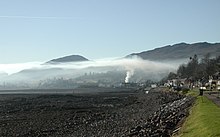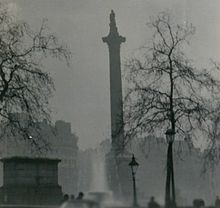Smokeless fuel

Smokeless fuel is a type of solid fuel which either does not emit visible smoke or emits minimal amounts during combustion. These types of fuel find use where the use of fuels which produce smoke, such as coal and unseasoned or wet wood, is prohibited.
As a result of many places banning smoke and pollution, studies have shown that overall air quality improved, and there were fewer annual deaths related to smoke.
History

Coal was widely used for domestic cooking and heating during the Victorian period and up to the early 1950s in most urban areas in Britain. However, low-quality
London

In 1952, the
Benefits
Smokeless coal is more efficient than a conventional open coal fire indoors because the high working temperature is released into the room as infrared radiation, as can be judged by the bright red color of a mature fire. The hot gases produced are lost up the chimney, thereby reducing efficiency just as in an open coal fire. The gases mainly consist of carbon dioxide, carbon monoxide, and some water vapor. With little or no smoke or similar volatile compounds, chimneys remain cleaner longer and require cleaning less frequently. The main combustion reaction is:
- C (s) + O2 (g) → CO2 (g)
In a restricted supply of air or oxygen toxic carbon monoxide can be formed:
- 2 C (s) + O2 (g) → 2 CO (g)
Charcoal, either unprocessed or as shaped
Calorific value
Smokeless fuels generally have a high
Downsides
Smokeless fuels also have some disadvantages. Typically they can be harder to
Since all
See also
- Briquette
- Clean Air Act of 1963 § 1990 amendments
- Clean Air Act 1956
- Coke (fuel), a smokeless fuel made by carbonizing coal
- Energy density
References
- ^ "What is Smokeless Fuel? - Definition from Safeopedia". safeopedia.com. Retrieved 2019-02-14.
- ^ "Smog kills thousands in England". HISTORY. Retrieved 2019-02-14.
